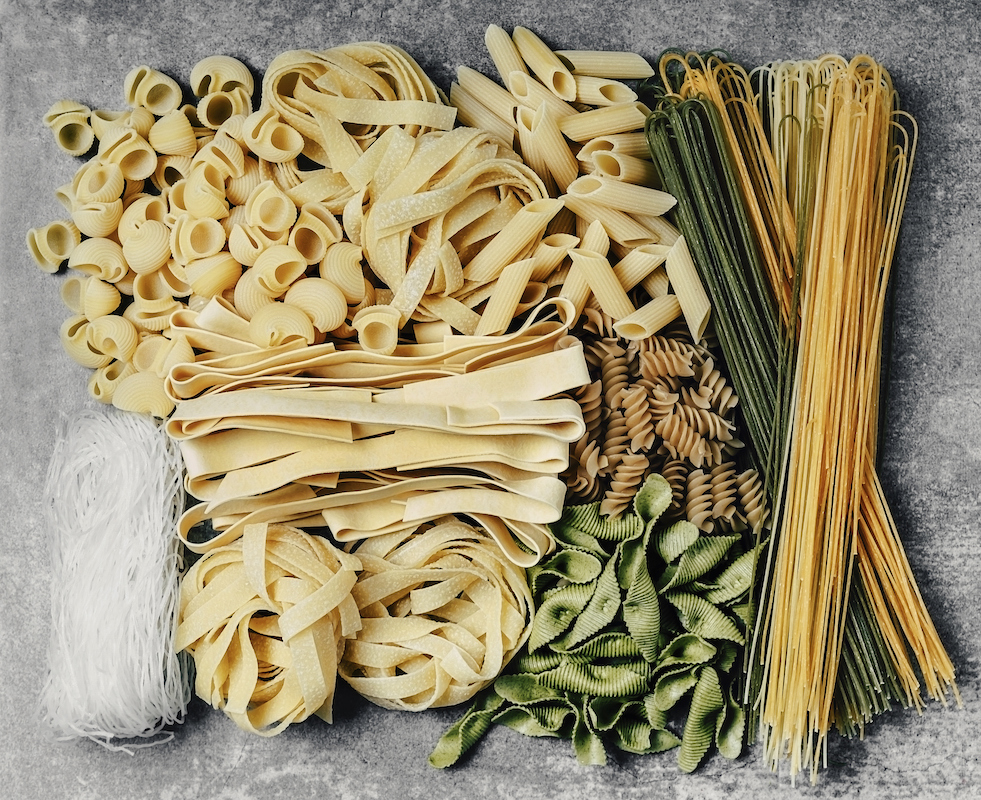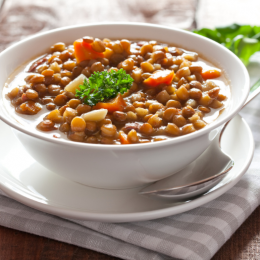5 Healthy Noodles You Should Be Eating, According to a Dietitian
Carbs and gluten are not your enemy if you make the right choices at the grocery store. Tuck into a warm bowl of these easy, healthy noodles tonight.

Pasta is one of those universally comforting foods that transcends generations. Whether it’s spaghetti, penne, or fusilli, noodles are versatile and tasty pantry staples. But traditional pasta contains refined grains, carbohydrates, and gluten. All of those need to be restricted if you follow certain diets for weight loss, diabetes, or celiac disease.
Despite all the bad press about pasta, people who eat it may be healthier eaters than those that don’t. A recent study in Frontiers in Nutrition found that people who eat pasta may have a higher-quality diet quality and higher intake of nutrients such as folate, iron, magnesium, and fiber than those who don’t eat pasta.
Classic pasta isn’t made from whole grains, although it’s often enriched with iron and B vitamins. But there are many other types of noodles that provide your body with even more nutrients. Here are five nutritious noodles to slurp up for lunch or dinner. We’ll leave the sauce choices up to you.
Add SilverSneakers to your wellness routine! Classes and events are happening daily at participating gyms, online through SilverSneakers LIVE, and at community centers near you. Activate your free online account to get started.
Whole Wheat Noodles
Whole-wheat pasta is easy to find and bumps up your pasta-night nutrition. Compared to noodles made from white flour, it contains more fiber. Most older people don’t eat enough fiber, which is good for our digestion and heart health — and it keeps us feeling full for longer.
A study in the Journal of the Academy of Nutrition and Dietetics found that whole grains improve blood sugar and inflammation levels, which means that long-term heart health may benefit from replacing regular pasta with the whole-wheat variety.
Whole-wheat pasta has some other nutritional tricks up its sleeve too. A cup of cooked whole-wheat spaghetti or penne contains as much protein as an egg.
Some people need to get used to the taste of whole-wheat pasta. But your taste buds should adjust quickly, and using good sauces can help with the transition.
Pro Tip: To season your pasta, put a pinch of salt into the cooking water just as it comes to a boil. It’ll dissolve into the water and enhance the flavor of the noodles. If you have high blood pressure, talk to your doctor about added sodium.
Soba Noodles
A traditional Japanese noodle, soba noodles are made with buckwheat. That is a whole grain (or technically a seed) that’s related to rhubarb — not wheat. Buckwheat is gluten-free, despite its name. Buckwheat has a lot of nutrients that are useful for seniors, including B vitamins, iron, and magnesium.
If you cook these noodles ahead of time, let them cool down in the fridge before eating them. The traditional way to serve them is in a cold noodle salad. Cold noodles contain more resistant starch. Resistant starch is a type of fiber that may lead to better gut and immune health.
Nutty-tasting soba noodles also cook faster than most other whole-grain pastas. Just keep in mind that some soba noodles are made with wheat flour too. If you want a gluten-free meal, check nutrition labels for a brand made solely with buckwheat.
Pro tip: Unlike Western-style noodles, soba should be rinsed with water immediately after draining to help wash away excess starch that can make the noodles gummy.
Brown Rice Noodles
This was the original gluten-free, whole-grain pasta option, and it’s still easy to find. It’s made from brown rice flour, and it’s higher in fiber, magnesium, and potassium than pasta made from refined grains.
Typically, these noodles contain about the same amount of protein and fiber as whole-wheat pasta. A review in BMJ Open found that eating brown rice may lower the risk of developing type 2 diabetes, while white rice raised the risk. The higher amounts of fiber in brown rice may help improve blood sugar control and control appetite, both of which may lower the chance of developing diabetes.
At the grocery store, scan at the ingredient list and make sure brown rice is the first thing on there. Some gluten-free pasta blends are made with “rice flour” which is the same as white rice.
Pro tip: Firmer shapes of brown rice pasta such as penne and rotini are more forgiving and won’t turn as mushy if slightly overcooked.
Legume Noodles
Supermarket shelves are now filled with different shapes of pasta made from chickpeas, lentils, and peas. Every 2-ounce serving of chickpea legume pasta has about 13 g of protein, which is double the amount found in most grain-based kinds of pasta.
Protein helps you maintain muscle mass, which is essential for healthier aging. A study in the journal Clinical Nutrition also found that swapping out some of the eggs, bread, rice, or potatoes for legumes lowers the risk of developing type 2 diabetes.
In recent years, manufacturers have worked hard to improve the texture and flavor of legume-based noodles, so they don’t taste like beans. They can be a bit more expensive and harder to find, so check the gluten-free section of your grocery store if you don’t see boxes of these noodles in the pasta aisle.
Subscribe to our newsletter
It's quick and easy. You could be one of the 13 million people who are eligible.
Already a member? Click to discover our 15,000+ participating locations.
Follow Us
Pro tip: Legume noodles can go from perfect to soggy in a hurry, so stick to the recommended cooking time. The noodles also foam a lot in boiling water. Be careful of overflow and skim it off as needed with a spoon. They also should be rinsed with cold water after draining.
Veggie Noodles
It’s become popular to use veggies like zucchini, beet, or sweet potato as noodles for a lower-carb alternative to traditional pasta. They’re lower-carb and add more age-defying antioxidants to your meals.
Sweet potato noodles will provide a substantial amount of beta-carotene, a nutrient that may help improve brain functioning with age. Zucchini will supply more vitamin C than traditional pasta, and a study in the Journal of Nutrition found that adults with the highest levels of vitamin C had the highest levels of muscle mass too.
Even though low-calorie veggie noodles are a great way to sneak more vegetables into your diet, they probably won’t be as satisfying as regular noodles. Prepare a more substantial meal by adding a protein source like a meat sauce, shellfish, or tofu. You can also use half whole wheat spaghetti and half veggie noodles in a dish to give you more carbs to feel satisfied.
Pro tip: Veggie noodles can be eaten raw for a crisp bite or simmered into a softer, silkier texture. If you have a spiralizer, you can make your own. This can save you money if you regularly serve noodles made from vegetables.
See our sources:
Pasta eaters and healthy diets: Frontiers in Nutrition
Brown rice and diabetes: BMJ Open
Sweet potatoes and cognitive function: British Journal of Nutrition
Vitamin C and muscle mass: Journal of Nutrition
Check Your SilverSneakers Eligibility Instantly
SilverSneakers members can go to thousands of gyms and fitness locations across the nation, plus take SilverSneakers LIVE online classes that are designed for seniors of all levels. If you have a Medicare Advantage plan, it may include SilverSneakers—at no additional cost. Check your eligibility instantly here.
Already a member? Get your SilverSneakers member ID and exclusive fitness content by activating your online account here.
Not eligible for SilverSneakers? You can still get 200+ free SilverSneakers On-Demand videos and stay in touch with us by creating your online account.




